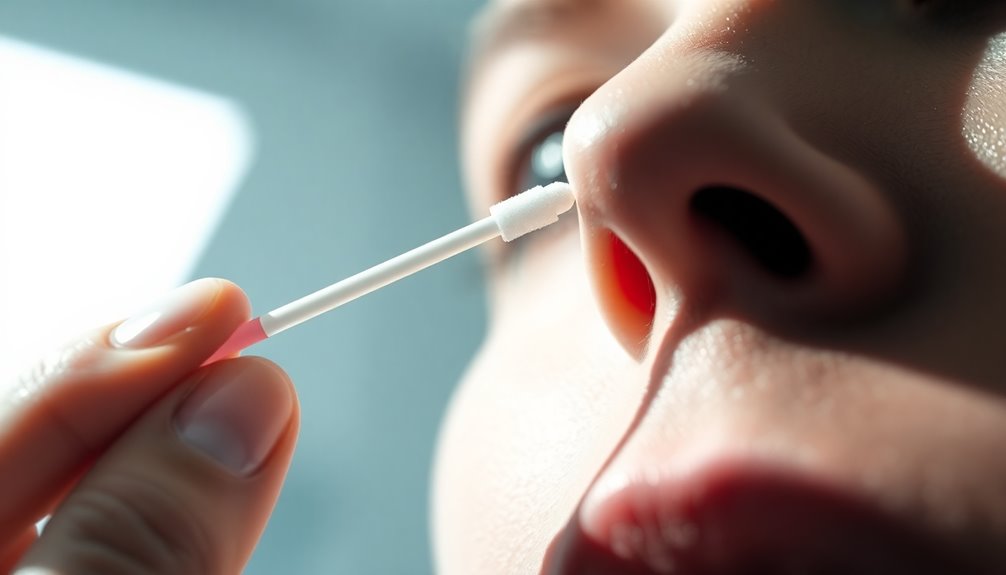HPV testing detects the high-risk virus linked to most cervical cancers, while Pap smears examine cervical cells for abnormalities. HPV tests are recommended starting at age 30 and often combined with Pap smears every five years, whereas Pap smears alone are typically done every three years after age 21. Understanding how they work and when to get tested can help you make informed choices about your cervical health—keep going to learn more about the differences and benefits.
Key Takeaways
- HPV testing detects high-risk HPV DNA/RNA, identifying the virus responsible for most cervical cancers, while Pap smears examine cervical cells for abnormalities.
- Pap smears screen for cellular changes, whereas HPV tests directly identify the presence of high-risk HPV infections.
- HPV testing is typically recommended from age 30 every 5 years, while Pap smears start at age 21 and are done every 3 years.
- Combining both tests enhances detection accuracy, with co-testing recommended every 5 years for women over 30.
- Understanding their differences helps women make informed decisions about cervical cancer screening and health management.
How Each Test Works
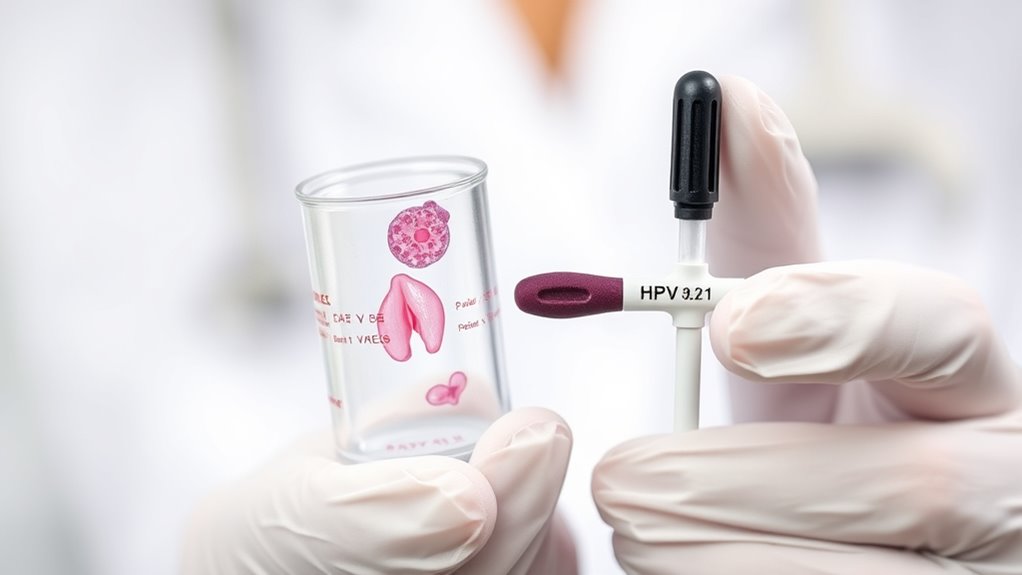
Both the Pap smear and HPV test are designed to detect potential issues in your cervical cells, but they work in different ways. During a Pap smear, your healthcare provider collects cells from your cervix using a small brush or spatula. They examine these cells under a microscope to look for abnormalities or changes that could indicate pre-cancerous conditions. In contrast, the HPV test identifies the presence of high-risk HPV types by analyzing cells from your cervix for viral DNA or RNA. It doesn’t look for cell changes directly but instead detects the virus that can cause such changes. Both tests are quick procedures, usually performed during a pelvic exam, and are essential tools for monitoring your cervical health. Additionally, understanding the importance of early detection can significantly improve treatment outcomes and reduce the risk of cervical cancer.
The Primary Purpose of HPV Testing and Pap Smears

The primary purpose of HPV testing and Pap smears is to detect early signs of cervical abnormalities that could develop into cancer. HPV testing identifies the presence of high-risk human papillomavirus strains linked to cervical cancer. Pap smears examine cervical cells for abnormal changes, allowing for early intervention. Together, these tests help catch potential issues before symptoms appear, increasing the chances of successful treatment. They are essential tools for screening women at risk, ensuring that abnormal cells are identified and monitored promptly. Early detection through these tests can prevent the progression to invasive cancer, saving lives. Your health care provider will recommend appropriate screening based on your age and health history to maintain cervical health effectively.
Age Recommendations and Screening Intervals
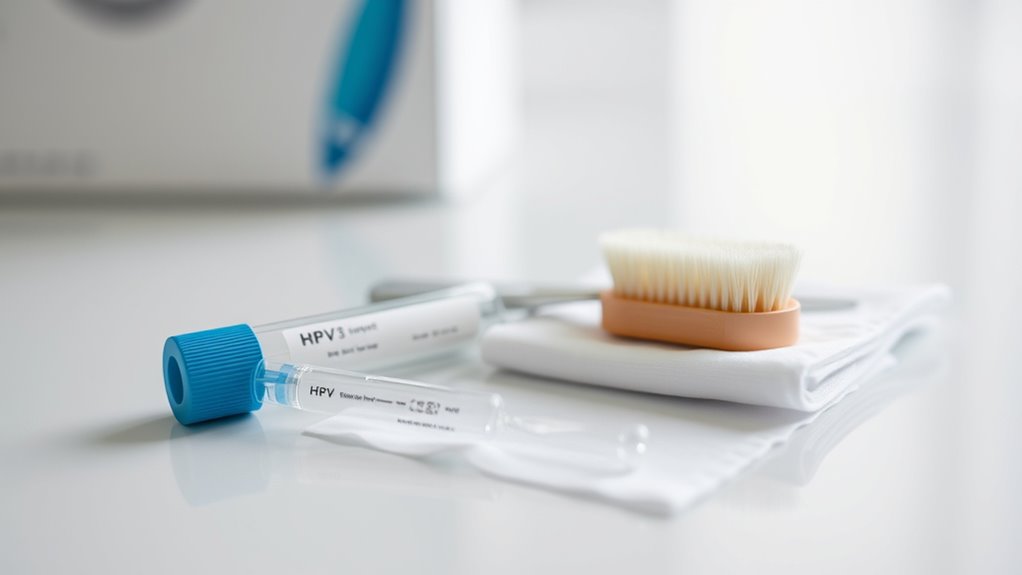
Understanding the recommended age range and screening intervals helps you stay proactive about cervical health. Guidelines suggest when to start and how often to get tested, depending on your age. Knowing these points guarantees you get the right screenings at the right times. For example, understanding the screening intervals for HPV testing versus Pap smears can help prevent potential health issues.
Recommended Age Range
At what age should you start and stop HPV testing and Pap smears? Typically, women should begin Pap smears at age 21, regardless of sexual activity, and continue regularly until around age 65. HPV testing is usually recommended starting at age 30, often combined with Pap smears every five years, or Pap smears alone every three years. These guidelines help catch precancerous changes early while avoiding unnecessary procedures in younger women, whose HPV infections often resolve on their own. After age 65, screening may cease if you’ve had consistent negative results, but your healthcare provider will assess your individual risk. Following these age recommendations ensures effective screening while minimizing potential harms from over-testing. Additionally, understanding the natural history of HPV infections can inform appropriate screening intervals and reduce overtreatment.
Screening Frequency Guidelines
To maximize the benefits of cervical cancer screening while minimizing unnecessary procedures, it’s important to follow recommended screening intervals based on your age and test results. For women aged 21 to 29, a Pap smear every three years is typically enough, even if HPV testing is included. If you’re 30 or older, you might opt for co-testing with both Pap and HPV every five years, or a Pap alone every three years. If your previous tests were normal, your provider might suggest less frequent screenings. However, if results are abnormal, more frequent testing or additional procedures might be necessary. Always follow your healthcare provider’s advice, as they tailor screening schedules to your individual risk factors, ensuring early detection without overtesting. Additionally, understanding the testing guidelines can help you make informed decisions about your health.
Detecting Abnormalities and Risks
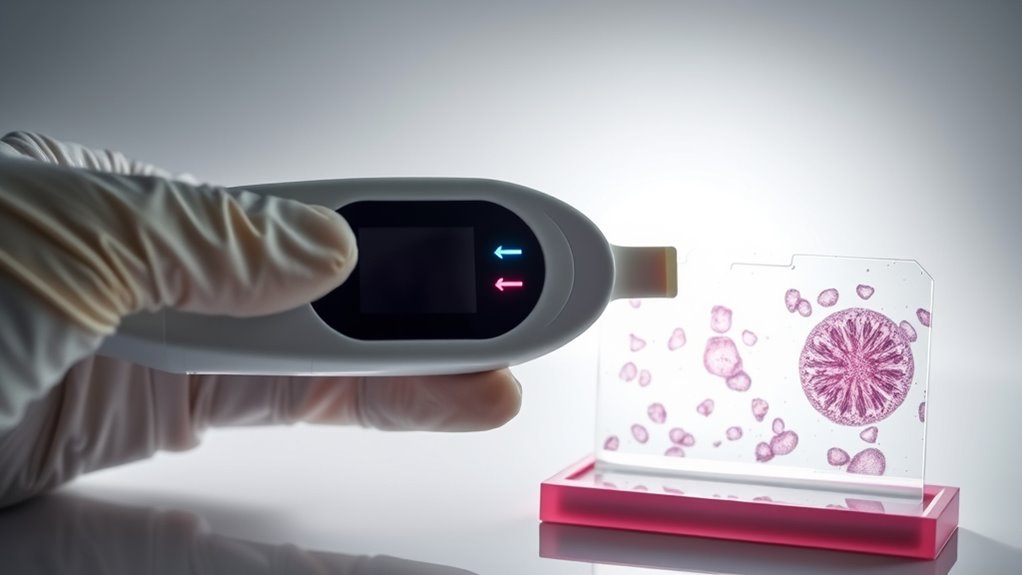
Both HPV testing and Pap smears play essential roles in detecting abnormal cervical cells and evaluating cancer risk. A Pap smear examines cervical cells under a microscope to identify abnormalities, such as precancerous changes. It helps you catch issues early before they develop into serious problems. HPV testing detects the presence of high-risk HPV types that can cause cervical cancer. Knowing whether you have these infections allows for better risk assessment and timely intervention. While Pap smears reveal physical cell changes, HPV tests identify potential causes of these changes. Together, they provide a thorough view of your cervical health. Detecting abnormalities early gives you the advantage of early treatment, reducing the chance of cancer development. Regular screenings and understanding cybersecurity vulnerabilities associated with health data storage are crucial for maintaining your cervical health. Staying vigilant with regular screenings is essential for maintaining your cervical health.
Combining HPV Testing With Pap Smears

Combining HPV testing with Pap smears offers a more thorough approach to cervical cancer screening. This method increases detection accuracy by identifying both cellular changes and high-risk HPV infections. When used together, they improve early diagnosis and reduce false negatives. Here’s a quick comparison:
| Aspect | HPV Testing | Pap Smear |
|---|---|---|
| Purpose | Detect high-risk HPV types | Identify abnormal cells |
| Sensitivity | Higher for HPV presence | Detects cellular changes |
| Screening Frequency | Every 5 years (if negative) | Every 3 years |
| Effectiveness | Better combined for prevention | Good for initial screening |
| Targeted Detection | Virus infection | Cell abnormalities |
Additionally, understanding the role of HPV in cervical health can help you make more informed screening choices. This combined approach helps you stay proactive about your cervical health.
Making an Informed Choice for Your Health
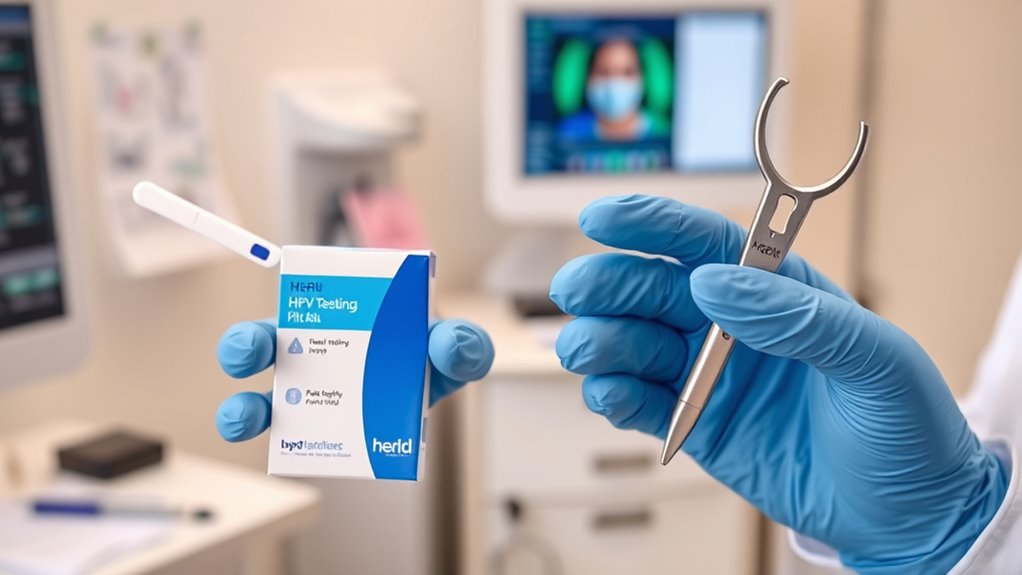
Choosing between HPV testing and a Pap smear depends on understanding how each test works and their benefits. When you know the differences and advantages, you can make a decision that best supports your health. Being informed helps you take control and make choices confidently. Understanding the role of wall organization systems can also contribute to a more comfortable healthcare environment.
Understanding Testing Differences
Understanding the differences between HPV testing and Pap smears is essential for making an informed decision about your health. HPV testing looks for the presence of high-risk virus types that can lead to cervical cancer, while a Pap smear checks for abnormal cells on your cervix. Here’s how they differ:
- Purpose: HPV tests detect the virus itself; Pap smears identify cell abnormalities.
- Timing: HPV testing is often used for screening women over 30; Pap smears are standard for women aged 21-65.
- Results: A positive HPV test indicates risk, not certainty of cancer; abnormal Pap results suggest further investigation.
- Frequency: HPV testing may be done less frequently, depending on age and history, compared to Pap smears.
Knowing these differences helps you choose the right screening method.
Benefits of HPV Test
Opting for an HPV test offers several important benefits that can help you stay proactive about your health. First, it detects high-risk HPV strains that may cause cervical cancer, often before any symptoms appear. This early identification allows you to take timely steps, such as increased monitoring or treatment, reducing your risk of developing serious health issues. Unlike Pap smears, which primarily identify abnormal cells, HPV testing directly screens for the virus responsible for most cervical cancers. It’s more sensitive and can provide clearer insight into your HPV status. This information helps you make informed decisions about your health and follow-up care. Additionally, understanding your HPV status through testing can guide discussions with your healthcare provider about preventive measures, such as vaccination or lifestyle changes. Overall, HPV testing empowers you with critical knowledge, enabling you to address potential risks early and maintain better cervical health.
Making Informed Decisions
Making informed decisions about your cervical health means understanding the differences between HPV testing and Pap smears, so you can choose the screening method that best suits your needs. Consider these key points:
- Know how often each test is recommended based on your age and health history.
- Understand that HPV tests detect high-risk strains, while Pap smears look for abnormal cells.
- Ask your healthcare provider about the benefits and limitations of each method.
- Think about your comfort level and personal preferences in screening options.
Frequently Asked Questions
Can HPV Testing Replace Pap Smears Entirely?
You might wonder if HPV testing can fully replace Pap smears. While HPV tests can detect high-risk virus strains linked to cervical cancer, they don’t identify abnormal cells directly. Pap smears, on the other hand, find cell changes that could develop into cancer. For now, combining both tests provides the best screening, but ongoing research may change guidelines in the future. Always follow your healthcare provider’s recommendations.
Are There Any Side Effects From HPV Testing?
You might wonder if HPV testing has side effects. Generally, it’s a safe procedure with minimal risks. You could experience mild discomfort, like a slight pinching during the swab, or minor bleeding afterward. Rarely, some might feel irritation or soreness. Overall, HPV testing is well-tolerated, and serious side effects are uncommon. Always talk to your healthcare provider if you have concerns or experience unusual symptoms after the test.
How Accurate Is HPV Testing Compared to Pap Smears?
They say, “Forewarned is forearmed,” and that’s true here. HPV testing is more accurate at detecting the virus, especially in women over 30, making it a better early warning system. Pap smears, however, excel at finding abnormal cells that could lead to cancer. Combining both offers the best protection, giving you a clearer picture of your health and catching issues before they become serious.
Do HPV Tests Detect All Types of HPV?
You might wonder if HPV tests catch all types of HPV. They primarily detect high-risk HPV strains linked to cervical cancer, but they don’t identify every HPV type, especially low-risk ones that cause genital warts. While HPV tests are quite effective at spotting dangerous strains, they don’t cover every possible HPV type. Regular screenings and follow-up tests help guarantee thorough monitoring of your cervical health.
Is HPV Testing Covered by Most Insurance Plans?
You might worry about the cost of HPV testing, but most insurance plans do cover it. Insurance often considers it a preventive service, so you’ll likely pay little to nothing out of pocket. Check with your provider beforehand to confirm coverage and avoid surprises. Don’t let concerns about expenses stop you from getting essential screening—your health benefits are there to support you.
Conclusion
Did you know that HPV causes nearly all cervical cancers? Choosing between HPV testing and Pap smears can feel overwhelming, but understanding their differences helps you make informed decisions. Combining both tests increases detection accuracy, especially for women aged 30 and over. Regular screenings are vital—since early detection can prevent most cervical cancers. Stay proactive about your health, ask your doctor about the best screening plan for you, and prioritize your peace of mind.



